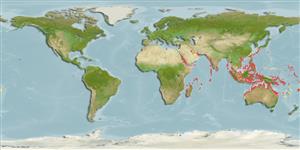>
Syngnathiformes (Pipefishes and seahorses) >
Syngnathidae (Pipefishes and seahorses) > Syngnathinae
Etymology: Halicampus: Greek, als, alis = salt + Greek, kampe = bend (Ref. 45335).
Environment: milieu / climate zone / depth range / distribution range
Écologie
marin récifal; profondeur 3 - 25 m (Ref. 9710). Tropical
Indo-West Pacific: northern Red Sea (Gulfs of Suez and Aqaba), Indonesia off Sumbawa Islands, Queensland in Australia, Port Moresby in Papua New Guinea, New Britain Islands and Guadalcanal Islands in the Solomon Islands.
Taille / Poids / Âge
Maturity: Lm ? range ? - ? cm
Max length : 18.0 cm TL mâle / non sexé; (Ref. 48635)
Description synthétique
Clés d'identification | Morphologie | Morphométrie
Épines dorsales (Total) : 0; Rayons mous dorsaux (Total) : 18 - 19; Rayons mous anaux: 4. Superior trunk and tail ridges discontinuous; inferior trunk ridge ending at anal ring; lateral trunk ridge continuous with inferior tail ridge; body rings 14 or 15 + 25-25. Colors vary with habitat, colorful on algae-rubble and dull on sand (Ref. 48635).
Adults inhabit reef flats where it is found in seagrass areas, among coral rubble and algae-covered rocks. Juveniles occur with round-leafed seagrasses on sand slopes, usually settling from pelagic state at about 8 cm long. Adults on sand or algae covered reefs to about 25 m depth (Ref. 48635). Ovoviviparous (Ref. 205). The male carries the eggs in a brood pouch which is found under the tail (Ref. 205). Solitary or in pairs (Ref 90102).
Life cycle and mating behavior
Maturities | Reproduction | Spawnings | Egg(s) | Fecundities | Larves
Male carries the eggs in a brood pouch (Ref. 205).
Dawson, C.E., 1985. Indo-Pacific pipefishes (Red Sea to the Americas). The Gulf Coast Research Laboratory Ocean Springs, Mississippi, USA. (Ref. 5316)
Statut dans la liste rouge de l'IUCN (Ref. 130435)
Menace pour l'homme
Harmless
Utilisations par l'homme
Outils
Articles particuliers
Télécharger en XML
Sources Internet
Estimates based on models
Preferred temperature (Ref.
123201): 25.2 - 29.3, mean 28.4 °C (based on 2080 cells).
Phylogenetic diversity index (Ref.
82804): PD
50 = 0.5002 [Uniqueness, from 0.5 = low to 2.0 = high].
Bayesian length-weight: a=0.00037 (0.00016 - 0.00085), b=3.18 (2.99 - 3.37), in cm total length, based on LWR estimates for this (Sub)family-body shape (Ref.
93245).
Niveau trophique (Ref.
69278): 3.4 ±0.5 se; based on size and trophs of closest relatives
Résilience (Ref.
120179): Haut, temps minimum de doublement de population inférieur à 15 mois (Preliminary K or Fecundity.).
Fishing Vulnerability (Ref.
59153): Low vulnerability (10 of 100).
